A Traveler’s Guide to Wuyuan Jiangwan: Nature, Culture, and Culinary Delights
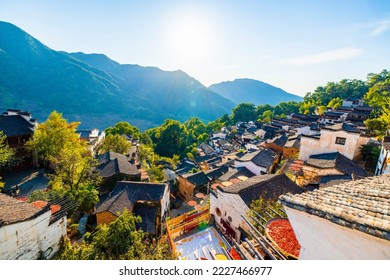
An Essential Guide to Visiting Wuyuan Jiangwan
In This Guide
- An Essential Guide to Visiting Wuyuan Jiangwan
- The Rich History and Legends of Wuyuan Jiangwan
- Main Highlights: What You Absolutely Can’t Miss
- Planning Your Visit: A Practical Guide
- Tickets: Prices, Booking, and Tips
- How to Get There: A Complete Transportation Guide
- Local Cuisine and Accommodation Nearby
- Frequently Asked Questions
- Final Thoughts on Your Trip
Nestled in the serene landscapes of Jiangxi Province, Wuyuan Jiangwan is a hidden gem that encapsulates the essence of traditional Chinese culture and history. Often referred to as “the most beautiful countryside in China,” this enchanting area is renowned for its well-preserved ancient villages, stunning seasonal scenery, and the rich tapestry of Hui culture. Here, visitors can immerse themselves in a world where time-honored traditions and breathtaking natural beauty intertwine, creating a truly unforgettable experience.
As you wander through the picturesque villages, you’ll encounter exquisite Hui-style architecture, vibrant fields of blooming rapeseed flowers, and the colorful spectacle of the Shaiqiu tradition during the autumn harvest. Each village, from Huangling to Jiangwan, tells its own story, reflecting the region’s illustrious past and the enduring spirit of its people. This is a place where ancient customs are not just preserved but celebrated, offering a unique glimpse into the heart of rural China.
Getting to Wuyuan is a breeze, thanks to its convenient transport connections. With high-speed trains linking major cities like Shanghai and Hangzhou, you can find yourself surrounded by the tranquil beauty of Wuyuan in just a few short hours. Whether you’re an avid photographer, a history buff, or simply seeking a peaceful retreat from the hustle and bustle of modern life, Wuyuan Jiangwan promises a captivating journey through the stunning landscapes and rich cultural heritage of this remarkable region.
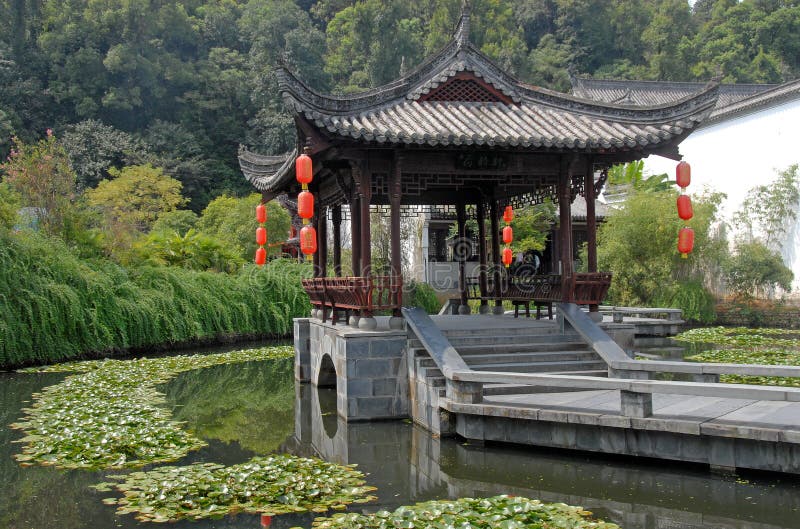
Wuyuan Jiangwan.
Prepare to be enchanted by this tranquil haven where nature and history converge, inviting you to explore the hidden treasures of Wuyuan Jiangwan.
The Rich History and Legends of Wuyuan Jiangwan
Wuyuan Jiangwan, a picturesque gem nestled in the heart of Jiangxi Province, is not only celebrated for its breathtaking landscapes but also for its rich tapestry of history and legends that echo through its ancient villages. As you wander through Jiangwan, the essence of a bygone era envelops you, offering a glimpse into a world where culture and tradition intertwine seamlessly with the natural beauty of the surroundings.
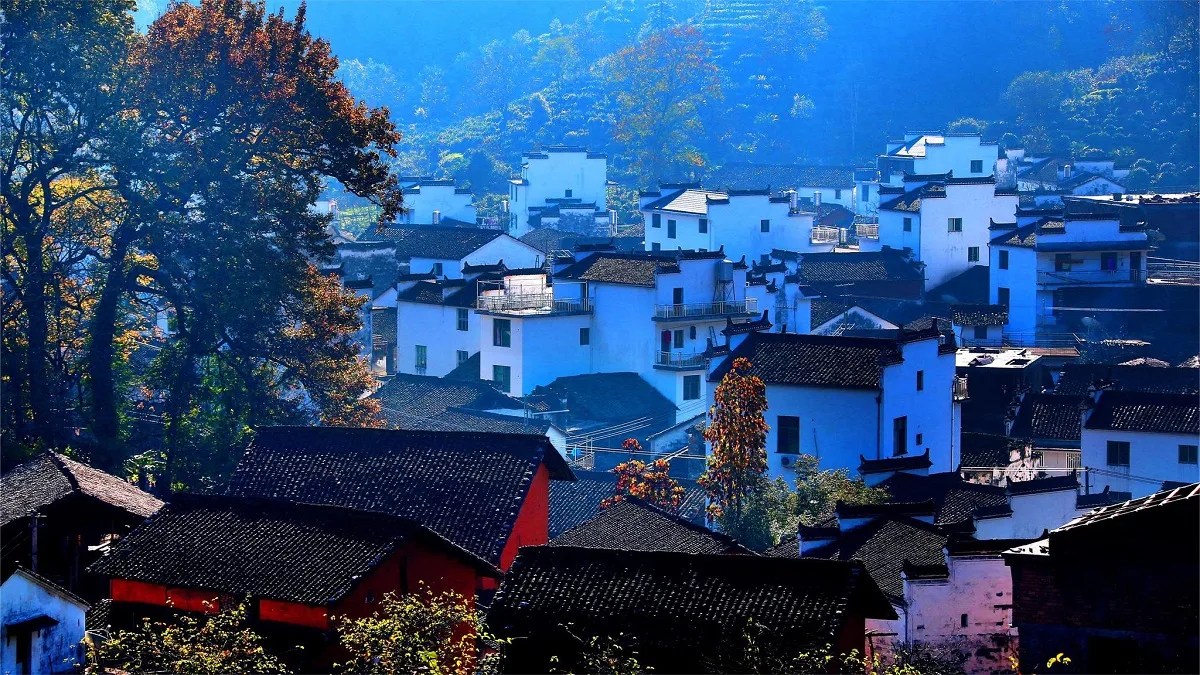
Wuyuan Jiangwan.
A Historical Overview
The roots of Wuyuan can be traced back to the Tang Dynasty in 740 AD when it was officially established as Wuyuan County under Huizhou Prefecture. This early foundation laid the groundwork for a thriving cultural hub that would flourish over the centuries. By the Song Dynasty, Wuyuan emerged as a center of education and scholarship, nurturing renowned figures such as the Neo-Confucian scholar Zhu Xi and the seal engraver He Zhen. This legacy of intellectual pursuit contributed significantly to the region’s rich Hui culture, reflected in its architecture, customs, and arts.
Wuyuan’s strategic location at the intersection of Jiangxi, Zhejiang, and Anhui provinces further facilitated its development as a commercial and cultural crossroads. The area became a bustling nexus for Hui merchants during the Ming and Qing dynasties, which is still evident in the well-preserved merchant houses and ancestral halls sprinkled throughout its villages.
Legends of Wuyuan Jiangwan
As with many historical regions, Wuyuan is steeped in enchanting legends that add an intriguing dimension to its identity. One such tale speaks of the Moon Bay, known for its crescent-shaped island that rises dramatically from the riverbanks. According to local lore, this bay was once the beloved spot of a celestial maiden who descended from the heavens to bathe in the river. The reflections of the surrounding Hui-style architecture on the water are said to symbolize her lingering presence, casting a magical aura over the landscape that enchants visitors even today.
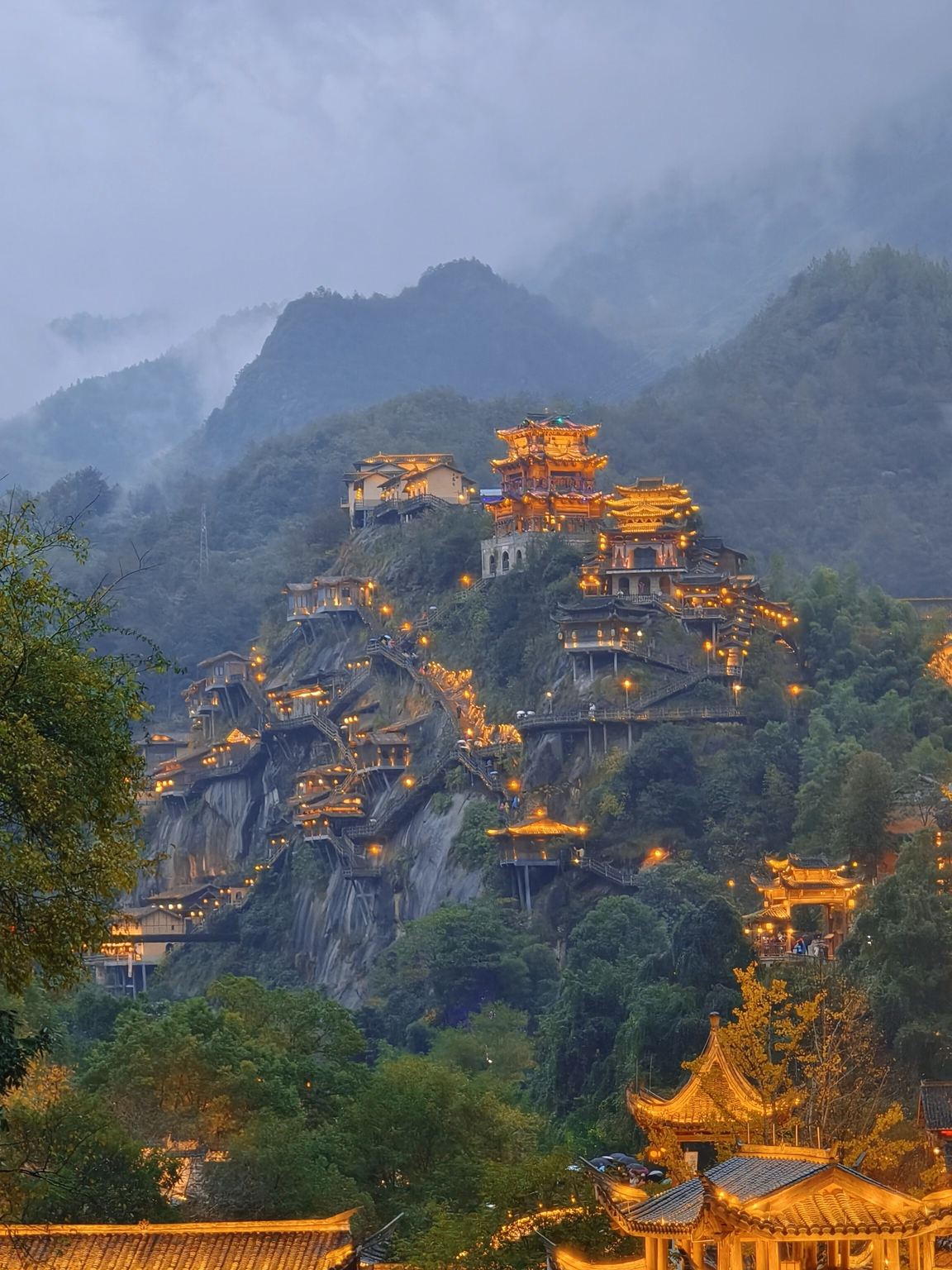
Wuyuan Jiangwan.
Another captivating legend involves Huangling Village, particularly its celebrated Shaiqiu tradition. It is said that a benevolent deity blessed the village with an abundant harvest, ensuring that the villagers would never go hungry. In gratitude, the villagers created the art of Shaiqiu—drying their colorful crops on rooftops and windowsills each autumn. This vibrant practice is not merely a means of food preservation but a homage to the deity, showcasing their gratitude through a stunning visual display that attracts travelers from far and wide.
Cultural Significance
The cultural significance of Wuyuan is further underscored by its preservation of Hui culture, one of the most prominent cultural identities in China. This heritage is vividly expressed in the region’s architecture, which features intricate carvings and designs that reflect the philosophical and aesthetic values of the Hui people. The ancient villages, particularly Jiangwan Village, boast well-preserved residences from the Ming and Qing dynasties, embodying the spirit of a community that honors its past.
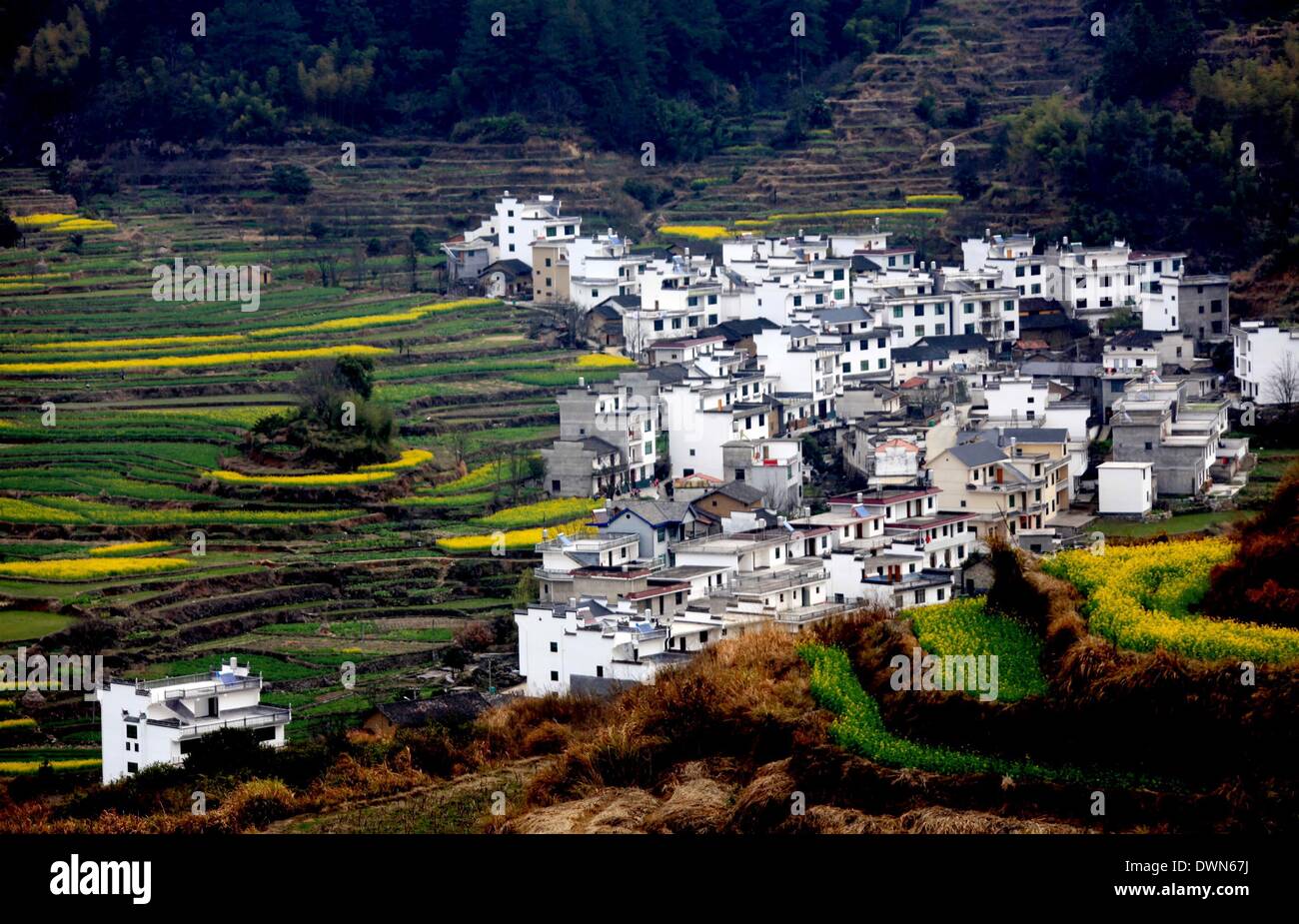
Wuyuan Jiangwan.
Moreover, Wuyuan’s rich agricultural practices, including the cultivation of Wuyuan Green Tea, are steeped in tradition. The region’s tea-picking practices, especially during the spring months, are not only a celebration of the local flora but also a continuation of a legacy that has been cherished for centuries. The tea itself is often regarded as a tribute to the emperors during the Ming and Qing dynasties, further enhancing Wuyuan’s historical allure.
Conclusion
As you explore Wuyuan Jiangwan, you will be enveloped by a profound sense of history and legends that breathe life into its serene landscapes. This enchanting region is not just a visual feast but a living repository of stories, traditions, and cultural legacies that beckon travelers to immerse themselves in its richness. Whether you are drawn to the majestic autumnal scenes of Shaiqiu or the ethereal beauty of Moon Bay, Wuyuan Jiangwan promises an unforgettable journey into the heart of China’s cultural heritage.
Main Highlights: What You Absolutely Can’t Miss
When visiting Wuyuan Jiangwan, a treasure trove of natural beauty and rich cultural heritage awaits. This enchanting region, often hailed as the “most beautiful countryside in China,” offers a captivating blend of stunning landscapes, ancient architecture, and vibrant local traditions. Here’s a detailed guide to the main highlights that you absolutely cannot miss during your visit:

Wuyuan Jiangwan.
1. Huangling Village
One of the most picturesque villages in China, Huangling is particularly renowned for its Shaiqiu tradition. In autumn, the vibrant colors of dried crops adorning ancient rooftops create a stunning visual tableau. The village’s tiered houses, nestled against the mountainside, provide a perfect backdrop for photography enthusiasts. Don’t forget your camera!
2. Jiangling Village
Jiangling is famous for its expansive rapeseed flower fields, which bloom gloriously in spring. This village features a breathtaking landscape of golden flowers cascading across terraced fields, framed by distant mountains and traditional Hui architecture. Visit between mid-March and early April for the best views of this floral spectacle.
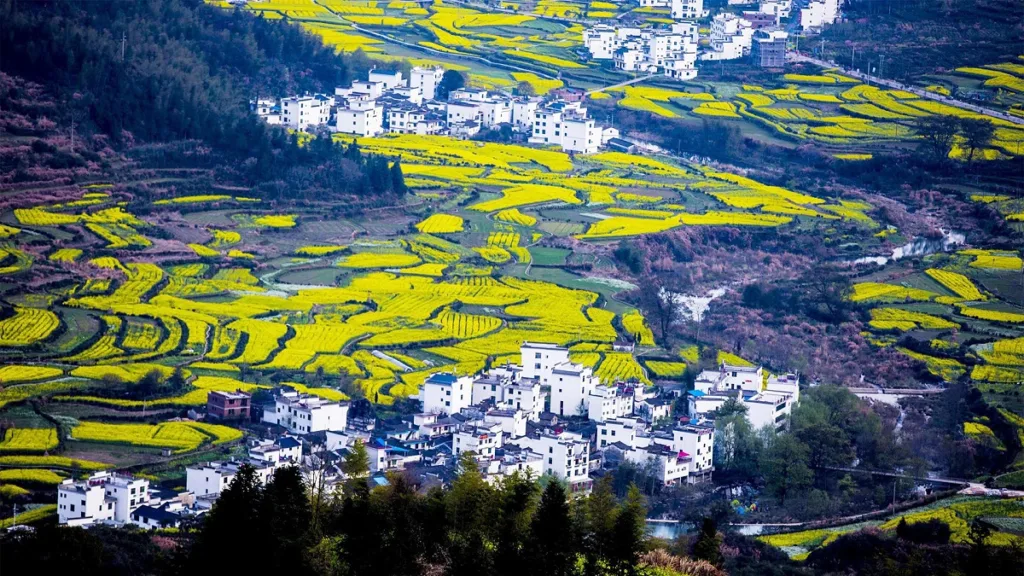
Wuyuan Jiangwan.
3. Likeng Village
With nearly a thousand years of history, Likeng Village retains many structures from the Ming and Qing dynasties. Meandering streams and creeks add to its charm, evoking the serene beauty of Jiangnan water towns. Stroll through its picturesque alleys and immerse yourself in its tranquil ambiance.
4. Jiangwan Village
Known for its well-preserved official residences from the Ming and Qing dynasties, Jiangwan Village offers a glimpse into the life of Hui merchants. Be sure to explore the intricate fengshui design of the village’s bridges and wells, which reflect the deep connection between nature and architecture in ancient Chinese culture.
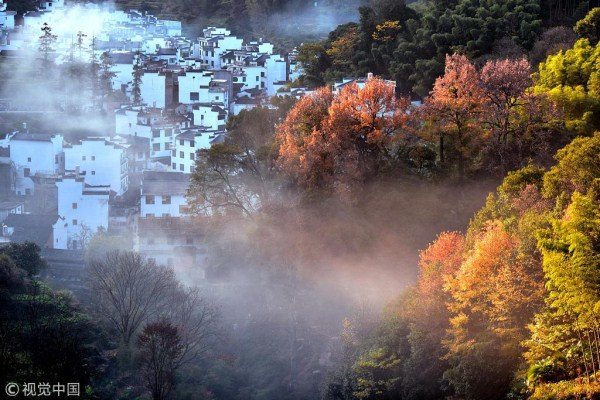
Wuyuan Jiangwan.
5. Xiaoqi Village
Divided into Upper and Lower Xiaoqi, this village showcases the exquisite “Three Carvings” art (brick, stone, and wood). The winding alleys paved with blue stones and the ancient ancestral halls tell stories of Wuyuan’s rich heritage. It’s a perfect spot for those interested in traditional craftsmanship.
6. Wangkou Village
A hub for Hui merchants during the Ming and Qing dynasties, Wangkou Village is steeped in history. Visit the Yu Family Ancestral Hall, celebrated for its architectural beauty and intricate carvings. Interact with local villagers to gain insights into their traditional way of life, which remains largely intact.
7. Moon Bay
On your way to Likeng Village, stop by Moon Bay, where a crescent-shaped island nestled between riverbanks creates a scene reminiscent of a traditional Chinese ink painting. Here, the reflections of Hui-style architecture on the water make for a serene and picturesque experience.
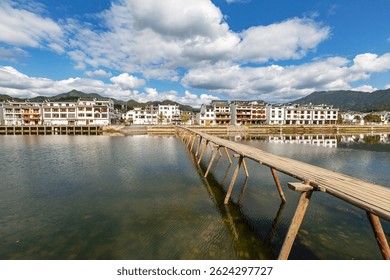
Wuyuan Jiangwan.
8. Qingyuan Village
Hidden in the depths of mountain valleys, Qingyuan Village offers a pristine environment and a glimpse of ancient customs and farming culture. Its remoteness has preserved its beauty and traditions, making it an ideal spot for those seeking a more tranquil experience.
9. Experience Shaiqiu Culture
If your visit coincides with autumn, engage in the Shaiqiu tradition. Witness local farmers drying colorful crops on rooftops and windowsills, creating a vibrant rural landscape that harmonizes with the ancient architecture.
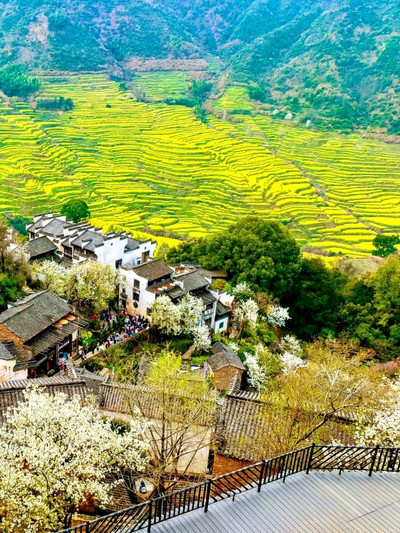
Wuyuan Jiangwan.
10. Enjoy Nuo Dance
Don’t miss the chance to experience Nuo Dance, a mesmerizing traditional performance often held during festivals. Dancers, adorned in colorful masks and costumes, embody ancient spirits and folklore, giving you a unique insight into Chinese cultural heritage.
11. Tea Picking and Making
Participate in the delightful experience of tea picking and making, especially during spring. The terraced tea gardens provide not only a stunning view but also a chance to learn about Wuyuan’s rich tea culture, which dates back to the Ming Dynasty. Dive into this immersive activity to appreciate the craftsmanship behind Wuyuan Green Tea, recognized worldwide for its quality.
Conclusion
Wuyuan Jiangwan is a destination that captures the essence of Chinese rural life and culture. Whether you’re wandering through ancient villages, admiring breathtaking landscapes, or engaging with local traditions, each moment spent here offers a deeper understanding of the region’s historical and cultural significance. Plan your visit to experience the serene beauty and rich heritage that make Wuyuan an unforgettable part of your travels in China.
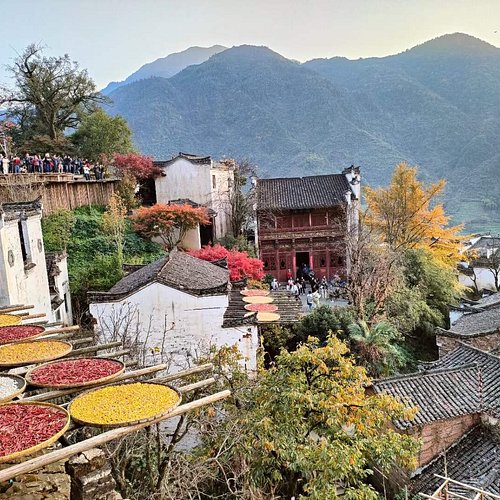
Wuyuan Jiangwan.
Planning Your Visit: A Practical Guide
Your Essential Guide to Visiting Wuyuan Jiangwan
Wuyuan, known as one of the most picturesque regions in China, offers a harmonious blend of stunning natural landscapes, rich history, and profound cultural heritage. Nestled in the northeastern part of Jiangxi Province, this enchanting county is a must-visit for anyone looking to experience the beauty of rural China. Here’s everything you need to know to plan your visit.
Getting There
By Train:
Wuyuan is easily accessible by high-speed train, making it convenient for international travelers. Here are some travel times from major cities:
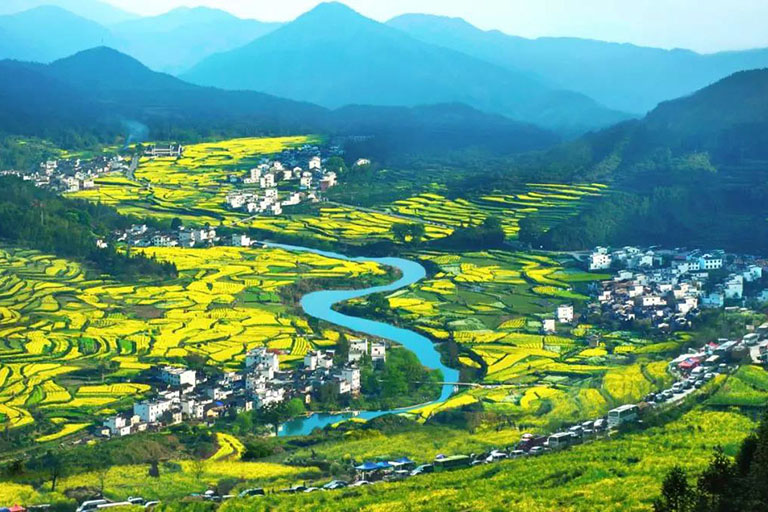
Wuyuan Jiangwan.
- Shanghai: Approximately 3 hours
- Hangzhou: Approximately 3 hours
- Huangshan: Less than 30 minutes
- Jingdezhen: Less than 30 minutes
Local Transportation:
Once you arrive, local buses and taxis can take you to various villages and attractions. Renting a bike is also a popular option for exploring the beautiful countryside at your own pace.
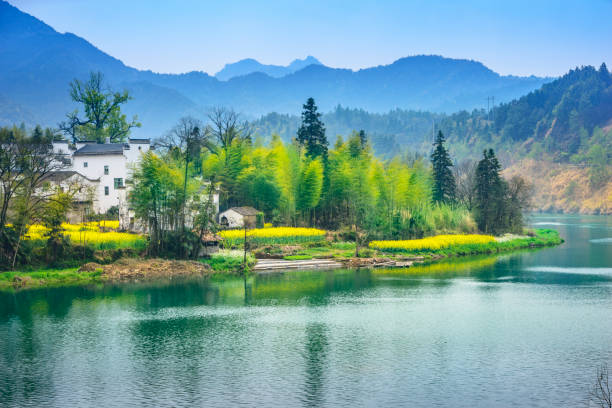
Wuyuan Jiangwan.
Best Time to Visit
The ideal time to visit Wuyuan is during the spring and autumn months:
- Spring (Mid-March to Early April): Witness the breathtaking sea of rapeseed flowers in full bloom, a hallmark of Wuyuan’s landscape.
- Autumn (September to November): Experience the traditional Shaiqiu culture when locals dry their harvests, creating a colorful tapestry against the ancient Hui-style architecture.
Duration of Stay
- 1 Day: Perfect for a brief visit during the peak seasons to see the rapeseed flowers or participate in Shaiqiu.
- 2-3 Days: Ideal for exploring the major attractions, including a mix of villages and natural scenery.
- 4 Days or More: Allows for a deeper dive into Wuyuan’s culture, cuisine, and diverse activities, including tea picking and local festivals.
Must-See Attractions
Wuyuan is home to a plethora of ancient villages, each showcasing the beauty of Hui-style architecture and traditional rural life. Here are some highlights:
- Huangling Village: Famous for its Shaiqiu tradition, this village is a feast for the eyes in autumn.
- Likeng Village: A nearly 1000-year-old village that charms visitors with its serene waterways and ancient buildings.
- Jiangwan Village: Known for its well-preserved official residences from the Ming and Qing dynasties.
- Jiangling Village: The best spot to view the stunning rapeseed flower fields in spring.
- Xiaoqi Village: Features beautiful stone-paved alleys and exquisite carvings.
- Wangkou Village: Offers insights into the history of Hui merchants and traditional architectural artistry.
Unique Experiences
- Tea Picking and Making: Participate in this culturally rich experience during the spring months, especially in Xiaoqi and Dazhangshan.
- Shaiqiu Culture: Visit during autumn to witness the vibrant drying crops adorning rooftops and windowsills.
- Nuo Dance: Attend a performance of this ancient dance to gain insights into traditional Chinese beliefs and aesthetics.
Suggested Itineraries
- East Route: Focus on iconic villages like Jiangling and Huangling, along with scenic spots like Moon Bay and Likeng.
- North Route: Explore the historical attractions such as Sixiyan Village and the Rainbow Bridge amidst autumn colors.
- West Route: Enjoy a less-traveled path with ecological tea gardens and the serene Wengong Mountain.
Accommodation
Wuyuan offers a variety of accommodation options ranging from boutique hotels to guesthouses. Staying in a traditional Hui-style inn can enhance your cultural experience. Be sure to book in advance during peak seasons.
Practical Tips
- Language: While Mandarin is the official language, English is not widely spoken. Learning a few basic phrases can enhance your experience.
- Cash: Many places may not accept credit cards, so having cash on hand is advisable.
- Cultural Respect: When visiting local villages, be respectful of customs and ask permission before taking photos of residents.
Conclusion
Wuyuan Jiangwan is a treasure trove of natural beauty and cultural richness, making it a unique destination for travelers interested in exploring the heart of rural China. With its stunning landscapes, ancient architecture, and vibrant traditions, Wuyuan promises an unforgettable experience. Plan your visit to immerse yourself in this enchanting countryside and discover the essence of Chinese history and culture.
Tickets: Prices, Booking, and Tips
Ticket Information for Wuyuan Jiangwan Scenic Area
Visiting Wuyuan Jiangwan (上饶婺源江湾景区) offers an enchanting glimpse into the picturesque landscapes of China’s countryside, famous for its ancient Hui-style villages and stunning seasonal views. Here’s everything you need to know about ticket prices, booking options, and tips for a seamless experience.
Ticket Prices
- General Admission:
- Adults: Approximately RMB 100 (about $15 USD)
- Children (under 1.2 meters): Free of charge
-
Students & Seniors: Discounts available with valid ID, typically around RMB 50 (about $7.50 USD)
-
Seasonal Variations:
- Prices may fluctuate during peak seasons, particularly during the blooming season of rapeseed flowers in spring (mid-March to early April) and the Shaiqiu tradition in autumn (September to October). Expect slight increases in ticket prices during these times.
Booking Options
- Online Reservations:
-
Tickets can be booked in advance through official travel websites or apps like Trip.com or Klook. This is highly recommended during peak seasons to avoid long queues.
-
On-Site Purchase:
-
Tickets are available at the entrance of Wuyuan Jiangwan Scenic Area. However, during peak times, the lines can be lengthy, so early arrival is wise.
-
Guided Tours:
- Consider booking a guided tour package through reputable travel agencies. This often includes transportation, local guides, and entrance fees, allowing for a more immersive experience without the hassle of navigation.
Tips for Visiting
- Best Time to Visit:
-
To witness the breathtaking sea of rapeseed flowers, plan your visit from mid-March to early April. For the Shaiqiu culture, late September to early October is ideal.
-
Arrive Early:
-
Arriving early not only allows you to beat the crowds but also gives you more opportunities for stunning photographs in the soft morning light.
-
Local Transportation:
-
Consider renting a bike or hiring a local driver to explore the scenic routes between villages. Public transportation options are limited in rural areas.
-
Combine with Other Attractions:
-
Wuyuan Jiangwan is part of a broader network of scenic spots. If time permits, explore nearby villages such as Huangling and Likeng, which are renowned for their unique architecture and cultural significance.
-
Cultural Etiquette:
- Respect local customs, especially when visiting traditional homes and participating in local activities like tea picking or the Nuo Dance. Always ask for permission before taking photographs of people.
By planning ahead and understanding the ticketing process, you can fully immerse yourself in the historical and cultural richness that Wuyuan Jiangwan has to offer. Enjoy your journey through this captivating part of China!
How to Get There: A Complete Transportation Guide
Getting to Wuyuan Jiangwan: Your Comprehensive Transportation Guide
Nestled in the breathtaking landscapes of Jiangxi Province, Wuyuan Jiangwan is a captivating destination that showcases the beauty of traditional Chinese rural life. For international travelers eager to explore this enchanting region, understanding how to reach Wuyuan is essential. Below, you’ll find a detailed guide to navigating your way to this picturesque locale.
By Air
Nearest Airports:
– Nanchang Changbei International Airport (KHN): This is the closest major airport, located about 250 kilometers from Wuyuan. It offers both domestic and limited international flights.
– Huangshan Tunxi International Airport (TXN): Approximately 100 kilometers away, this airport serves as another gateway, primarily accommodating domestic flights.
Getting to Wuyuan from the Airport:
– From Nanchang: You can take a high-speed train from Nanchang to Wuyuan, which takes about 3 hours. Alternatively, taxis and private car hires are available, though they may take up to 4 hours.
– From Huangshan: A high-speed train ride from Huangshan to Wuyuan will take around 30 minutes, making it a convenient option.
By Train
High-speed rail is one of the most efficient ways to reach Wuyuan. The county is well-connected to major cities:
- From Shanghai: Direct high-speed trains operate from Shanghai Hongqiao Railway Station to Wuyuan, with a travel time of approximately 3 hours.
- From Hangzhou: High-speed trains from Hangzhou to Wuyuan take around 2.5 to 3 hours, offering a smooth and quick journey.
- From Jingdezhen: A short train ride of about 30 minutes will take you from Jingdezhen to Wuyuan, making it an ideal stop for ceramic enthusiasts.
By Bus
If you prefer overland travel, long-distance buses are available from several nearby cities:
- From Nanchang: Buses operate regularly from Nanchang’s main bus station to Wuyuan, with a journey time of roughly 4-5 hours.
- From Jingdezhen: Buses are available and take around 1.5 hours to reach Wuyuan.
Getting Around Wuyuan
Once you arrive in Wuyuan, exploring its scenic villages and attractions can be done in several ways:
- Private Car Hire: Renting a car or hiring a private driver is a fantastic way to explore at your own pace, especially since many attractions are spread out.
- Local Transport: Taxis and local buses can be found in Wuyuan, but it’s advisable to have your destinations written in Chinese, as English may not be widely spoken.
- Bicycle Rentals: For a more immersive experience, consider renting a bicycle. The tranquil countryside offers beautiful paths for cycling enthusiasts.
Best Time to Visit
Plan your trip based on the seasonal highlights:
– Spring (Mid-March to Early April): Ideal for witnessing the vibrant sea of blooming rapeseed flowers.
– Autumn (September to November): Experience the Shaiqiu tradition, where colorful crops are dried on rooftops, creating picturesque scenery.
Conclusion
Reaching Wuyuan Jiangwan may seem daunting at first, but with the variety of transportation options available, you’ll find that the journey is as delightful as the destination itself. Whether you choose the speed of a high-speed train or the scenic route by bus, prepare yourself for an enchanting adventure into one of China’s most beautiful countryside areas. Happy travels!
Local Cuisine and Accommodation Nearby
Savoring Wuyuan: A Taste of Local Flavors and Comfortable Stays
Wuyuan, often celebrated for its breathtaking landscapes and rich cultural heritage, also offers a delightful culinary scene and a variety of accommodation options that cater to international travelers. Whether you’re sampling local delicacies or unwinding in charming lodgings, you’ll find experiences here that enhance your exploration of this picturesque region.
Local Cuisine: A Culinary Journey through Hui Flavors
Wuyuan’s cuisine is deeply rooted in Hui culture, characterized by its emphasis on fresh ingredients and traditional cooking techniques. Here are some must-try dishes that reflect the region’s culinary heritage:
-
Hui-style Braised Pork (红烧肉): This dish features tender pork belly slow-cooked with soy sauce, sugar, and spices, resulting in a rich and savory flavor. Often served with steamed rice, it’s a local favorite that showcases the region’s love for balanced flavors.
-
Steamed Buns (包子): Fluffy and soft, these steamed buns are filled with a variety of ingredients such as pork, vegetables, or mushrooms. They’re perfect for a quick snack as you explore the villages.
-
Wuyuan Green Tea (婺源绿茶): Renowned for its high quality, Wuyuan Green Tea is a must-try for tea enthusiasts. The tea is often served with meals, allowing you to appreciate its subtle flavors that complement local dishes.
-
Dried Vegetable Medley (干菜): This dish highlights the Shaiqiu tradition, where seasonal vegetables are dried and preserved. The medley often includes chilies, radish, and greens, reflecting the local farming practices.
-
Chili Pepper Sauce (辣椒酱): A staple in many local dishes, this sauce adds a spicy kick and is often used as a condiment to enhance the flavor of meats and vegetables.
For an authentic dining experience, local eateries and family-run restaurants can be found throughout the villages, where you can enjoy these dishes made with love and tradition.
Accommodation: Where Comfort Meets Culture
Wuyuan offers a range of accommodation options that allow you to immerse yourself in the local culture while enjoying modern comforts. Here are some recommendations:
-
Boutique Guesthouses: Many traditional Hui-style guesthouses are available, offering a unique opportunity to stay in beautifully restored buildings that reflect the region’s architectural heritage. Look for places like Liangjing Inn and Huangling Yiyuan, where you can enjoy cozy rooms with stunning views of the surrounding countryside.
-
Eco-friendly Hotels: For those who appreciate sustainability, consider staying at eco-friendly hotels such as Wuyuan Eco Resort. These accommodations often feature green practices and are set amidst nature, allowing for a tranquil escape.
-
Farm Stays: Experience rural life by opting for a farm stay. Places like Wangkou Village Farm Stay offer a chance to engage with local farmers, learn about traditional practices, and enjoy home-cooked meals made from fresh produce.
-
Luxury Hotels: If you prefer more upscale accommodations, the Wuyuan International Hotel provides modern amenities and services. It’s conveniently located for exploring the area while offering comfort and elegance.
Conclusion
As you traverse the captivating landscapes of Wuyuan, indulge in its local cuisine and find comfort in its diverse accommodations. Whether you’re savoring a plate of braised pork or sipping on fresh green tea, the flavors and experiences here will undoubtedly enrich your journey through one of China’s most beautiful rural regions.
Frequently Asked Questions
Frequently Asked Questions about Wuyuan Jiangwan
1. What is Wuyuan Jiangwan known for?
Wuyuan Jiangwan is renowned for its stunning natural landscapes, particularly its vibrant fields of blooming rapeseed flowers in spring and the picturesque scenes of traditional crop drying (Shaiqiu) in autumn. The area is also rich in Hui culture and history, featuring well-preserved ancient villages with distinctive Hui-style architecture.
2. How can I get to Wuyuan?
Wuyuan is easily accessible by high-speed train. From major cities like Shanghai or Hangzhou, the journey takes around three hours. If you’re coming from Huangshan or Jingdezhen, the train ride is even shorter, at about 30 minutes. Once in Wuyuan, local transportation options such as taxis and shuttle buses can help you navigate the area.
3. What is the best time to visit Wuyuan?
The ideal times to visit Wuyuan are during spring (mid-March to early April) when the rapeseed flowers bloom, and autumn (September to November) when the Shaiqiu tradition transforms the landscape with colorful crops. Each season offers a unique visual spectacle, so your choice may depend on what scenery you wish to experience.
4. How many days should I plan for my trip to Wuyuan?
– 1 Day: If you’re short on time, focus on key highlights like Jiangling and Huangling Villages during flower blooming or Shaiqiu season.
– 2-3 Days: This duration allows for a more comprehensive exploration of major attractions across two travel routes.
– 4 or More Days: With extended time, you can cover all three routes, immerse yourself in local culture, and indulge in culinary experiences.
5. Are there any cultural experiences I can participate in during my visit?
Absolutely! Visitors can engage in tea picking and making, experience the traditional Shaiqiu culture, and enjoy performances of Nuo Dance, which showcases ancient Chinese traditions and aesthetics. Such activities are great ways to delve deeper into Wuyuan’s rich cultural heritage.
6. What are some must-see attractions in Wuyuan?
Key attractions include:
– Huangling Village: Famous for its Shaiqiu tradition.
– Jiangling Village: Best for viewing blooming rapeseed flowers.
– Likeng Village: Offers a glimpse into Jiangnan water town charm.
– Wangkou Village: A hub for Hui merchant history with exquisite architecture.
7. What type of accommodations are available in Wuyuan?
Wuyuan offers a range of accommodations, from boutique hotels and guesthouses in ancient villages to more modern hotels in the town center. For a unique experience, consider staying in a traditional courtyard home, where you can enjoy the local atmosphere and hospitality.
8. Is it necessary to hire a guide for my trip to Wuyuan?
While it’s possible to explore Wuyuan independently, hiring a local guide can enhance your experience significantly. A knowledgeable guide can provide valuable insights into the history, culture, and hidden gems of the area, ensuring you get the most out of your visit. Consider booking a private tour for a personalized experience.
Final Thoughts on Your Trip
As your journey through Wuyuan Jiangwan comes to a close, you will find yourself enriched by the tapestry of history, culture, and nature that this enchanting region offers. From the vibrant rape flowers that sway in the spring breeze to the time-honored customs that echo through ancient villages, Wuyuan is a place where every moment is steeped in the profound narrative of Chinese heritage.
Reflect and Connect
Take a moment to reflect on the stunning landscapes you’ve witnessed—those golden fields against the backdrop of Hui-style architecture are not just sights, but stories that have been told for centuries. The warmth of the local community, the delectable flavors of Hui cuisine, and the captivating performances of Nuo Dance will linger in your memory long after you’ve departed. Each experience here is a thread woven into the larger fabric of Chinese culture, connecting you to a world that is both timeless and vibrant.
Preserve the Memories
Consider what you will carry back with you. Perhaps it’s the artistry of the ancient carvings in Xiaoqi Village or the serene beauty of the terraced fields in Jiangling. These memories are not just souvenirs; they are part of a larger narrative that continues to unfold in Wuyuan. Share your experiences and insights with others, allowing the stories of this remarkable place to resonate well beyond its borders.
Future Adventures Await
While your time in Wuyuan may be concluding, the adventures that await you in China are limitless. Whether you venture to bustling cities steeped in modern marvels or to serene landscapes echoing with history, may your travels continue to inspire and educate. Wuyuan Jiangwan is a shining jewel in China’s vast cultural landscape, and we hope it has ignited your passion for exploring the rich history and diverse traditions that this magnificent country has to offer.
As you pack your bags and prepare to depart, remember: the beauty of Wuyuan is not just found in its sights, but in the stories you bring home with you. Safe travels, and may your journey continue to unfold in the most beautiful of ways!